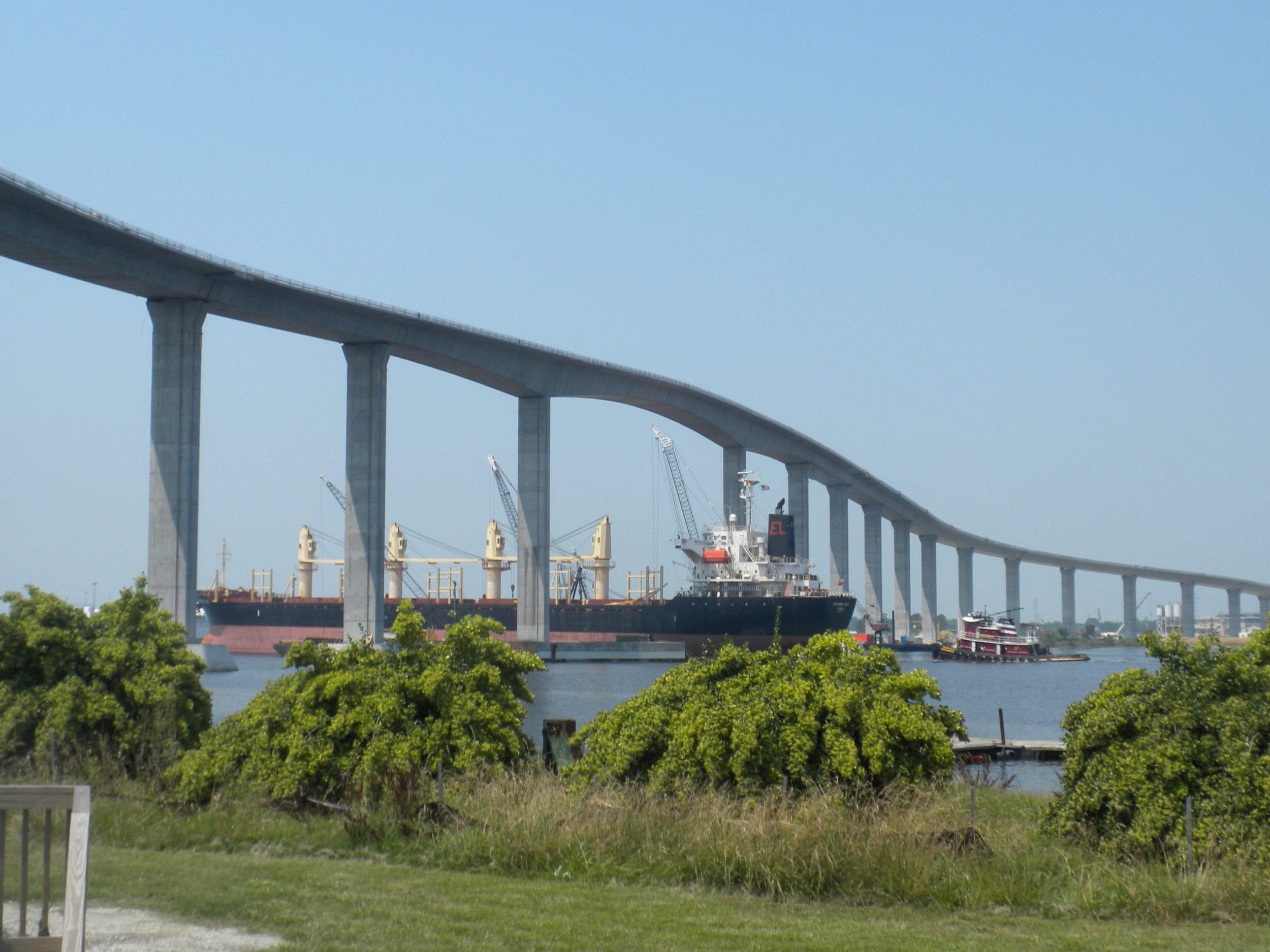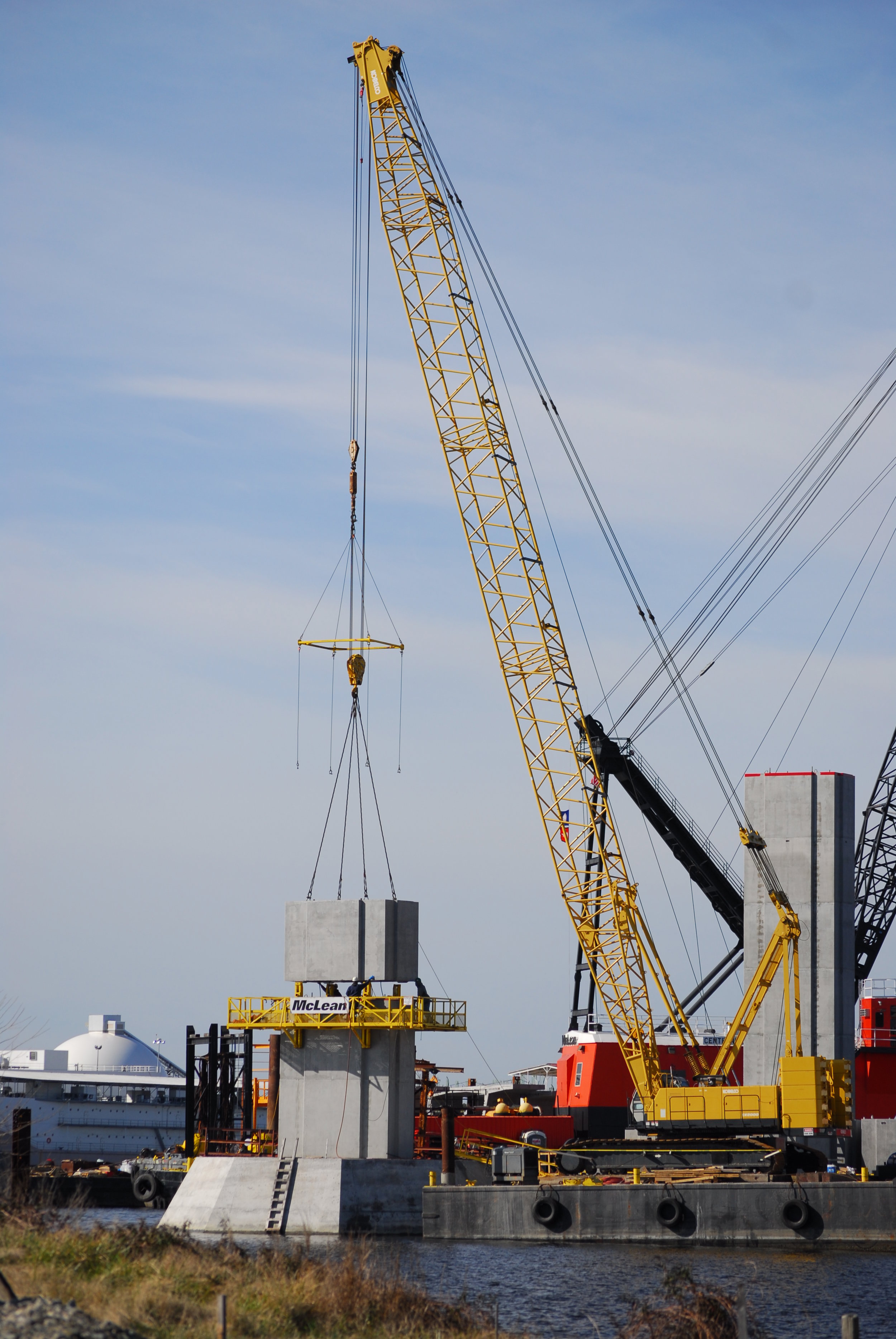South Norfolk Jordan Bridge
Atlantic Metrocast
Location:
South Norfolk Jordan Bridge LLC
Portsmouth and Chesapeake, VA
Schedule:
Project Start Date: 12/6/2010
Project Completion Date: 10/28/2012
Cost:
Total Project Cost: $90 million
Structure Length: 5,375’
Cost of Precast Concrete: $17.2 million
Involved Companies
Precast Concrete Producer
Atlantic Metrocast
3904 Burtons Point Road
Portsmouth, VA 23704
Architect
Figg Bridge Engineers
424 N Calhoun
Tallahassee, FL 32301
http://www.figgbridge.com/
Engineer of Record
Figg Bridge Engineers
424 N Calhoun
Tallahassee, FL 32301
http://www.figgbridge.com/
General Contractor
Figg Bridge Builders
424 N Calhoun
Tallahassee, FL 32301
http://www.figgbridge.com/
Background
The new 5,375’ long South Norfolk Jordan Bridge is a two-lane, fixed span, high-rise toll bridge over the Southern Branch of the Elizabeth River. On the west side of the river, the bridge ties into existing Elm Avenue and Victory Boulevard. On the east side, it connects to Poindexter Street and provides seamless access to I-464. The new, privately-funded bridge features two 12’ wide traffic lanes, two 8’ wide shoulders and a pedestrian sidewalk separated from traffic by a concrete barrier. A fully-electronic video capture system uses E-Z Pass to maximize convenience for users (but is not required for travel.) The new bridge replaced the former steel truss lift bridge that closed in November 2008. The 80 year-old bridge had deteriorated to the point that the bridge was deemed unsafe for vehicular travel.
A precast concrete segmental bridge was chosen for its redundancy, long-term durability, speed of construction and exceptional overall quality because of the manufacturing environment in which all precast elements are cast. In addition, the precast segmental construction technique of span-by-span with an under-slung truss gave the contractor needed flexibility to construct over an active EPA Superfund site. Balanced cantilever construction also provided the contractor with a means to construct the 385’ long main span over the busy navigational channel which, by USCG permit, was required to remain open to traffic at all times.
The new South Norfolk Jordan Bridge linking Chesapeake and Portsmouth, Virginia opened to traffic in October 2012, providing faster connections, more capacity, bigger clearances, and breathtaking views to enhance the quality of daily life in surrounding communities. Environmentally conscious construction, coupled with a focus on sustainability and community, means the South Norfolk Jordan Bridge will have a long-lasting impact on this southeastern Virginia area.
Precast Components includes:
Segmental Concrete Column Precasting (323 segments cast) (dimensions 16’l x 9’w x 10’tall typical)
Segmental Concrete Superstructure Precasting (533 segments cast)
All land piles (379 total 24” square precast concrete square piles)
All river piles (114 total 54” diameter precast concrete cylinder piles)
All cast-in-place concrete footings in the river (10 total)
All cast-in-place concrete footings on land (27 total, 15 in Portsmouth and 12 in Chesapeake)
Precast segmental column erection (total 34 columns)
Precast segmental main span unit (three span unit: 190’, 385’, 190’; 96 segments in all)
Span-by-span erection (32 spans total, 437 segments in all)
Challenges
The bridge crosses over an EPA Superfund Site in Portsmouth, Virginia where creosote and other chemicals have contaminated the soil and groundwater. Because of the construction hazards to workers, detrimental effect on the environment, and the extremely high cost of contaminated soil disposal, excavations for cast-in-place foundations and drilled shafts were eliminated from consideration. FIGG elected to design 24” square precast piles as the deep foundation elements on land. Through cooperation with the EPA, the precast piles were designed with “pointed ends”. These pointed ends penetrated contaminated layers of soil minimizing the potential for dragging contamination into lower substrata as apposed to “blunt end” piles.
Geotechnical information from soil borings indicated that a layer of unconsolidated material existed below the west approach. The design required 35’ of fill confined by mechanically stabilized earth (MSE) walls in this area. Several options were considered for ground improvements:
• Removal and replacement – high cost of disposing contaminated soils precluded removal
• Dynamic Compaction – Eliminated due to concerns with liberating contaminates from the soil
• Surcharging – Schedule and commitments for completing the bridge eliminated surcharging due to the six-eight months required
Therefore, a ground improvement scheme using 440 - 12” precast square piles was used to construct a settlement platform under the west approach to the bridge. The grid of precast concrete piles tied together with geotechnical membranes and concrete caps served to distribute the load from the fill alleviating the concerns due to the unconsolidated material while maintaining the schedule.
54” and 66” diameter precast cylinder piles were designed to take advantage of local precast suppliers and local contractor abilities in lieu of utilizing drilled shafts. Because of the contaminated subaqueous soils, drilled shafts would have increased the time for environmental permit approvals, increased construction costs, and would have been hazardous to construction workers and potentially the environment. The hollow cylinder piles were an advantage because they did not require excavating contaminated soils and all work could be done safely while minimizing the potential for the release of contaminates from the subaqueous soils.
While not exactly a design challenge, the following is something that bears mentioning. Mother nature was an ominous force throughout construction. The project site faced flooding, winter storms, and severe weather. On August 23, 2011, a magnitude 5.8 earthquake, the strongest to hit the East Coast in 67 years, originated less than 150 miles away. That same week, Hurricane Irene made landfall in the Outer Banks of North Carolina, just 100 miles south of the bridge, bringing strong winds and rains to the region. The bridge stood strong throughout each event without any issues, due in part to the use of concrete materials.
Innovations/Accomplishments
Construction time on this new, modern concrete bridge was less than two years. The use of precast concrete allowed the team to minimize the environmental impact of construction activity, traffic and noise. Each element of the bridge, the foundations, piers, and superstructure were manufactured in adjacent precast manufacturing facilities and then assembled on-site using local labor and local materials with the lowest energy use. Precasting of the bridge elements allowed for construction of the piers, approach spans, and main spans simultaneously. Pier erection started on the west end of the bridge while superstructure segments were continuing to be cast, working toward the east. To allow for delivery of precast segments, approach span construction also proceeded from west to east, following pier erection.
One of the challenges of replacing a lift span bridge in this location with a concrete, high-level fixed span and pedestrian friendly bridge was establishing the bridge geometry. The site constraints included clearance requirements over the river for navigation, railroad easements on both sides of the river, and existing tie-in points to surface streets. After extensive analysis, engineers achieved a bridge layout that provides the required United States Coast Guard (USCG) navigation clearance of 145’ (vertical) and 270’ (horizontal), gentle grades for pedestrian access, and appropriate rail clearances while also integrating the bridge seamlessly into the existing transportation network including I-464.
The final bridge layout is just over a mile in length, 5375’, with a total of 35 spans. The bridge approaches consist of typical spans that are 150’ long. The bridge’s main span unit over the navigation channel features three long spans of 190’ - 385’ - 190’.
The precast segmental column segments utilized high-performance self-consolidating concrete, the first use of this material for this purpose to our knowledge, to minimize concrete placement labor and equipment costs and to ensure a high-quality final aesthetic appearance of the segments.
195-ton, precast seal slabs for main pier foundation construction were utilized in lieu of other forming systems. The seal slabs were octagonal in shape measuring 44’-6” wide and 56’-6” long. Each seal slab was cast on a barge deck, floated to the site, and set with a barge mounted whirly crane. Once in place, the seal slabs supported the side forms for the cast-in-place foundations, provided a “in the dry” working platform for rebar placement, and supported the wet weight of the cast-in-place concrete. The top surface of the seal slab was slightly above mean water level allowing work to continue “in the dry”.
The Jordan Bridge is equipped with cameras to provide streaming video for monitoring traffic and help promote public awareness of this alternate route to avoid pollution generating congestion at adjacent crossings. In addition, a bridge-mounted weather station is web-accessible to alert the traveling public to any inclement travel conditions.
The tolling system at Jordan is the first in the region to provide all electronic open road tolling, which encourages the free flow of traffic without stopping at a toll plaza for payment.
Relevant Features
Improved thermal performance/reducing energy consumption
Accelerated construction
Aesthetic versatility (helped meet project’s aesthetic requirements)
Improved storm resistance
Helped meet sustainability goals
Improved safety and security to occupants
Cost-benefit
Improved blast resistance
Minimized construction site disturbance (e.g. tight site)
Increased service life/durability
Reduced long-term life-cycle costs
Improved seismic resistance
Contributed to improved IEQ (e.g. no mold, no VOCs, rapid enclosure…)
Structural versatility (precast used as at least part of the structural system)
Awards
International Bridge Conference 2014 Gustav Lindenthal Medal
ARTBA 2013 Globe Award for Bridges
ARTBA 2013 PRIDE Award









